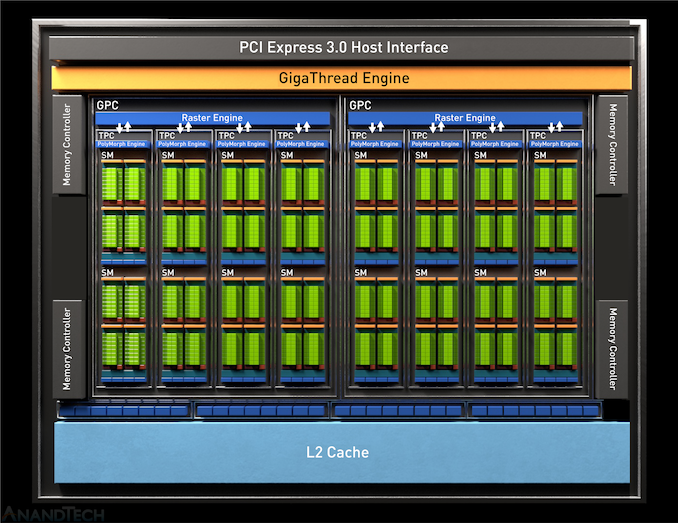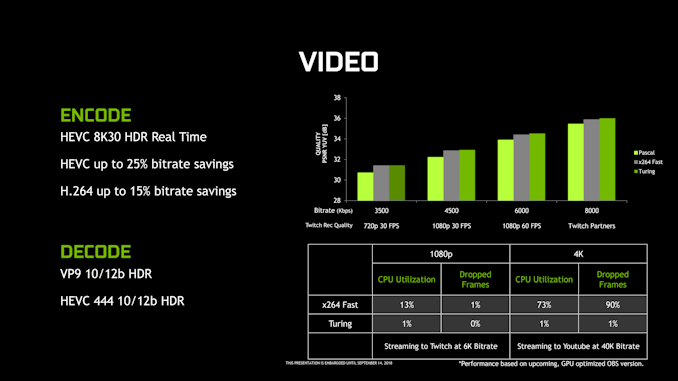The NVIDIA GeForce GTX 1650 Review, Feat. Zotac: Fighting Brute Force With Power Efficiency
by Ryan Smith & Nate Oh on May 3, 2019 10:15 AM ESTTU117: Tiny Turing
Before we take a look at the Zotac card and our benchmark results, let’s take a moment to go over the heart of the GTX 1650: the TU117 GPU.
TU117 is for most practical purposes a smaller version of the TU116 GPU, retaining the same core Turing feature set, but with fewer resources all around. Altogether, coming from the TU116 NVIDIA has shaved off one-third of the CUDA cores, one-third of the memory channels, and one-third of the ROPs, leaving a GPU that’s smaller and easier to manufacture for this low-margin market.
Still, at 200mm2 in size and housing 4.7B transistors, TU117 is by no means a simple chip. In fact, it’s exactly the same die size as GP106 – the GPU at the heart of the GeForce GTX 1060 series – so that should give you an idea of how performance and transistor counts have (slowly) cascaded down to cheaper products over the last few years.
Overall, NVIDIA’s first outing with their new GPU is an interesting one. Looking at the specs of the GTX 1650 and how NVIDIA has opted to price the card, it’s clear that NVIDIA is holding back a bit. Normally the company launches two low-end cards at the same time – a card based on a fully-enabled GPU and a cut-down card – which they haven’t done this time. This means that NVIDiA is sitting on the option of rolling out a fully-enabled TU117 card in the future if they want to.
By the numbers, the actual CUDA core count differences between GTX 1650 and a theoretical fully-enabled GTX 1650 Ti are quite limited – to the point where I doubt a few more CUDA cores alone would be worth it – however NVIDIA also has another ace up its sleeve in the form of GDDR6 memory. If the conceptually similar GTX 1660 Ti is anything to go by, a fully-enabled TU117 card with a small bump in clockspeeds and 4GB of GDDR6 could probably pull far enough ahead of the vanilla GTX 1650 to justify a new card, perhaps at $179 or so to fill NVIDIA’s current product stack gap.
The bigger question is where performance would land, and if it would be fast enough to completely fend off the Radeon RX 570. Despite the improvements over the years, bandwidth limitations are a constant challenge for GPU designers, and NVIDIA’s low-end cards have been especially boxed in. Coming straight off of standard GDDR5, the bump to GDDR6 could very well put some pep into TU117’s step. But the price sensitivity of this market (and NVIDIA’s own margin goals) means that it may be a while until we see such a card; GDDR6 memory still fetches a price premium, and I expect that NVIDIA would like to see this come down first before rolling out a GDDR6-equipped TU117 card.
Turing’s Graphics Architecture Meets Volta’s Video Encoder
While TU117 is a pure Turing chip as far as its core graphics and compute architecture is concerned, NVIDIA’s official specification tables highlight an interesting and unexpected divergence in related features. As it turns out, TU117 has incorporated an older version of NVIDIA’s NVENC video encoder block than the other Turing cards. Rather than using the Turing block, it uses the video encoding block from Volta.
But just what does the Turing NVENC block offer that Volta’s does not? As it turns out, it’s just a single feature: HEVC B-frame support.
While it wasn’t previously called out by NVIDIA in any of their Turing documentation, the NVENC block that shipped with the other Turing cards added support for B(idirectional) Frames when doing HEVC encoding. B-frames, in a nutshell, are a type of advanced frame predication for modern video codecs. Notably, B-frames incorporate information about both the frame before them and the frame after them, allowing for greater space savings versus simpler uni-directional P-frames.

I, P, and B-Frames (Petteri Aimonen / PD)
This bidirectional nature is what make B-frames so complex, and this especially goes for video encoding. As a result, while NVIDIA has supported hardware HEVC encoding for a few generations now, it’s only with Turing that they added B-frame support for that codec. The net result is that relative to Volta (and Pascal), Turing’s NVENC block can achieve similar image quality with lower bitrates, or conversely, higher image quality at the same bitrate. This is where a lot of NVIDIA’s previously touted “25% bitrate savings” for Turing come from.
Past that, however, the Volta and Turing NVENC blocks are functionally identical. Both support the same resolutions and color depths, the same codecs, etc, so while TU117 misses out on some quality/bitrate optimizations, it isn’t completely left behind. Total encoder throughput is a bit less clear, though; NVIDIA’s overall NVENC throughput has slowly ratcheted up over the generations, in particular so that their GPUs can serve up an ever-larger number of streams when being used in datacenters.
Overall this is an odd difference to bake into a GPU when the other 4 members of the Turing family all use the newer encoder, and I did reach out to NVIDIA looking for an explanation for why they regressed on the video encoder block. The answer, as it turns out, came down to die size: NVIDIA’s engineers opted to use the older encoder to keep the size of the already decently-sized 200mm2 chip from growing even larger. Unfortunately NVIDIA isn’t saying just how much larger Turing’s NVENC block is, so it’s impossible to say just how much die space this move saved. However, that the difference is apparently enough to materially impact the die size of TU117 makes me suspect it’s bigger than we normally give it credit for.
In any case, the impact to GTX 1650 will depend on the use case. HTPC users should be fine as this is solely about encoding and not decoding, so the GTX 1650 is as good for that as any other Turing card. And even in the case of game streaming/broadcasting, this is (still) mostly H.264 for compatibility and licensing reasons. But if you fall into a niche area where you’re doing GPU-accelerated HEVC encoding on a consumer card, then this is a notable difference that may make the GTX 1650 less appealing than the TU116-powered GTX 1660.












126 Comments
View All Comments
dr.denton - Saturday, May 4, 2019 - link
I honestly thought you were doing a weird "ye olde" kind of thing there. Thanks for clearing that up :DOxford Guy - Saturday, May 4, 2019 - link
"Wow. This card makes no sense."It makes perfect sense for Nvidia. The corporation's goal is to sell the lowest-quality product for the most money possible. Nvidia has, can, and does, rely on its brand mindshare to overcome deficits in its products at various price points, especially around the lower end. In other words, people buy it because it's painted green.
eva02langley - Sunday, May 5, 2019 - link
I don't believe this trend is going to keep going. Everyone is now checking reviews online before making their choice. No way this will pass like butter in a pan.cfenton - Sunday, May 5, 2019 - link
"RX570 8GB pulse, fro sapphire is cooler running, quieter, vastly higher build quality, >10% faster, twice the vram and 135W board power, which is perfectly fine even for potato OEM builds anyway."Not if the OEM build doesn't have a 6-pin PCIE cable. If you're building you own computer, then I agree that the 570 is a much better choice. However, if you want to do a quick upgrade to an older OEM system running a 750TI without a 6-pin, then the 1650 makes sense.
nunya112 - Friday, May 3, 2019 - link
Wow what a terrible product. a 570 beats it the price highlights that problem.SolarAxix - Saturday, May 4, 2019 - link
Many of my son's friends have lease-return desktop PCs their parents bought at a good price (i5/i7 2xxx to 4xxx) along with a 720p or 1080p LCD screen (usually less than a $300 investment) and many with SSDs. That being said, most of them use the iGPU (with a few of them with a lowend NVIDIA Quadro or AMD FirePro PCIe-based GPU). That being said, they want to be able to game at 720p/1080p with their friends and it usually doesn't cut it because of the iGPU or poor PCIe GPU.When it comes to upgrading the GPU, one of the drawbacks for these systems are the lack of a 6-pin PCIe connector from the power supply and lackluster power supplies in general which can't be easily upgraded. In the past, I've recommended they get a 1050 and they've been very happy with their purchase along with a quick 10 minute upgrade. I can see the 1650 being what I'd recommend to them in the future if it fits their budget.
I'm with with most of you though, where if you have a system that can handle a 570, that is a much better choice.
It would be interesting to see how big is the market for 75W GPUs based on desktop PCs which can't handle anything more than that (which has nothing to do with saving power on someone's electric bill).
Oxford Guy - Saturday, May 4, 2019 - link
If one has so little money that one has to do a significant amount of PC gaming on a machine that can't handle more than a 75W GPU perhaps it's time to reconsider spending that time on PC gaming.It seems like it would be a better idea to buy a used GPU and a cheap, but decent, PSU.
cfenton - Sunday, May 5, 2019 - link
Swapping out a GPU is relatively simple. Swapping out a power supply, especially in an OEM system with a custom power supply, is much more involved.yannigr2 - Saturday, May 4, 2019 - link
This is by far the most 1650 friendly review I have seen online. I mean, the choice of words, it's almost like someone is trying to not spoil his resume. Also it is the only review where AMD looks desperate, while it is a huge questionmark for how much time it will be willing to try to defend it's position with the RX 570 in the market. If only there where new cards coming from them in a couple of months, but I guess they don't prepare anything.Oxford Guy - Saturday, May 4, 2019 - link
Polaris is such an old architecture and it was very cheap to buy years ago, prior to the crypto surge. For it to be so competitive against the wealthiest GPU company's latest design is a sad statement about the quality of competition in the PC gaming space. Duopoly competition isn't good enough.If there were high-quality competition happening no company would be able to get away with putting overpriced turkeys into the market.